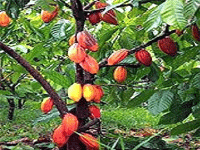 On the day of 29th, May 2009, Vietnamese Cocoa Development Dispatch Board – Ministry of Agriculture and Rural Development has organized its first regular meeting in 2009. Attending the meeting, Mr. Tran Ngoc Thoi, Vice Chairman of the Provincial People’s Committee, Dr. Pham Hong Phuong, Deputy Chief of Vietnamese Cocoa Dispatch Board and representatives of the Agriculture and Rural Development Departments of provinces which have planted cocoa trees.
On the day of 29th, May 2009, Vietnamese Cocoa Development Dispatch Board – Ministry of Agriculture and Rural Development has organized its first regular meeting in 2009. Attending the meeting, Mr. Tran Ngoc Thoi, Vice Chairman of the Provincial People’s Committee, Dr. Pham Hong Phuong, Deputy Chief of Vietnamese Cocoa Dispatch Board and representatives of the Agriculture and Rural Development Departments of provinces which have planted cocoa trees.
On the day of 29th, May 2009, Vietnamese Cocoa Development Dispatch Board – Ministry of Agriculture and Rural Development has organized its first regular meeting in 2009. Attending the meeting, Mr. Tran Ngoc Thoi, Vice Chairman of the Provincial People’s Committee, Dr. Pham Hong Phuong, Deputy Chief of Vietnamese Cocoa Dispatch Board and representatives of the Agriculture and Rural Development Departments of provinces which have planted cocoa trees.
According to the report of Vietnamese Cocoa Dispatch Board, up to the end of May 2009, in the whole country more than 10,000 ha have been planted cocoa trees, in which more than 8,300 ha intercropped (600 trees/ha) and more than 1,300 ha only planted cocoa trees (1,100 trees/ha); the area of harvesting is 4,750 ha.
Nowadays, most of cocoa seeds which are produced mainly propagation from 8 cocoa strains TD recognized good growth, high productivity, early harvest and beans are rather big. However, through some ideas from real producing, some strains are not very excellent (TD5 with thick cover, medium beans, easy to catch disease of rotten fruit; TD 2 is weak anti-pests), beans of these strains have rather acidity. Transplants are used in production mainly from graft trees, nursery gardens have not propagated natural trees, however the selection to recognize the first strain trees or first strain garden for production cocoa seeds have not been implemented by localities. So, to continue studying and creating by cross-breeding cocoa seeds in order to diversify new seeds, testing to recognize some more seeds in order to supply for production is an extreme need in the next time.
After the meeting, the representatives have visited models of planting successful cocoa trees in the localities of

 Previous page
Previous page Back to top
Back to top







